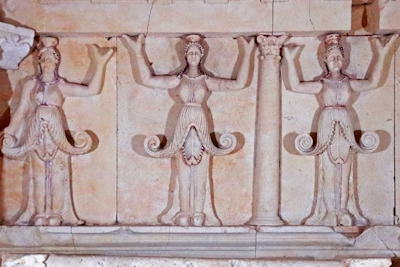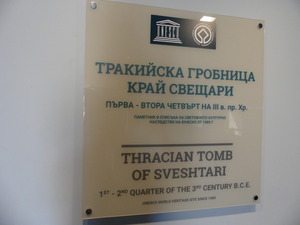Thracian tomb of Sveshtari

The Thracian Tomb of Sveshtari comprises a hypogeum from the 3rd century BCE.
The tomb's architectural decor is considered to be unique, with polychrome half-human, half-plant caryatids and painted murals. It represents local art from the Getes Thracian peoples, which was inspired by Hellenism.
Community Perspective: There are three tombs to explore here and all are authentic, so it provides a better visitor experience than the Thracian Tomb at Kazanlak. Read Els’s review for what to expect of a visit.


Map of Thracian tomb of Sveshtari
Community Reviews
Clyde

I visited this WHS in 2023. Although it certainly is less colourful than the Thracian tombs of Kazanlak and Alexandrovo, not only is it once again intact (its restoration reminded me a lot of Seokguram in South Korea) but it is also possible to visit its interior, which is most definitely its highlight (even though photography isn't allowed). Apparently the tomb is closed in winter and in summer it is closed on Mondays and Tuesdays.
I drove pretty early to the area, well ahead of the opening hours, so I had some time to kill which I spent exploring the nearby 4th and 3rd century BC razed Getic fortification and citadel remains, which together with the Sveshtari tomb make up what is called the Sboryanovo Archaeological Reserve. No matter how diverse and interesting Thracian heritage might be, time, destruction and rebuilding in times of war and peace, continual habitation, and treasure-hunting have wiped out a lot of it, reducing it to a set of tombs and shrines here, a treasure there, and a shrine in what today appears to be the middle of nowhere (a stark contrast when compared to the Kazanlak tomb!). Today archaeological research of the remains continues, but the trenches and low stone walls are not particularly spectacular. The south city wall can be seen passing through the main road from the Sveshtari Tomb to the village of Malak Porovets. Another piece of the fortifications, from the 3rd to 1st century BC, is in the Polyanata area, west of the Thracian city.
The area has been actively researched since the early 1980s, and has so far proved fertile ground for archaeologists, revealing not only astonishing architecture and gold treasures, but also important information about the religion, economy and social life of the Thracians. From the second half of the first millennium BC until the times of the Romans, the region was home to the Getae, a mighty and populous Thracian tribe which controlled the lands on both sides of the Danube. The Getae appeared in written historical sources in the 6th Century BC, when they were conquered by the Persians, and later fought, with varying success, with ancient Macedonia and the heirs of Alexander the Great. Research at Sboryanovo shows that at least in the 4th and 3rd centuries BC this region was the centre of the political power for the Getae kings. Two of them, Cothelas and Dromichaetes, who played a significant role in international politics of the day, are believed to have been buried in Sboryanovo. However, the end of the Thracian city at Sboryanovo came with a bang. It was destroyed for good by a strong earthquake around 250 BC.
At the Sveshtari tomb area, I paid for my ticket and English speaking guide and surprisingly we set off together towards the entrance of the first mound. Beneath the mound and above the tomb itself, there now is a concrete protective layer which I find is an excellent way of preserving the site while not only provided limited access but also preserve the way the tomb/mound looked like during Thracian times. Nowadays, the tomb is like a top-security vault, with an alarm which is deactivated by a long key kept by the guide. Once the alarm is deactivated, a modern system helps maintain a microclimate within the tomb area and constantly monitors tempature and humidity levels. Before viewing the tomb itself, there are a few plexiglass information boards and a UNESCO WHS inscription plaque (there are a couple of other brown signs outside too before getting to the tomb itself and just in front of it), and a few exhibits and photos, which although would have been ideally placed outside to have more time to read them, are a way of allowing time to the microclimate system to balance any changes brought about by opening the tomb and by the visitors' breathing. Plastic disposable shoe covers are also given prior to heading to the tomb proper.
The tomb was discovered in 1982 in one of the biggest mounds of the eastern necropolis known as Ginina Mogila. It is made up of three rooms that have unusual barrel-vaulted ceilings supported by four Doric and one Corinthian columns. The entrance is decorated with rectangular red frescoed columns and an epistyle with a frieze of ox heads, rosettes and garlands. The burial chamber is decorated with a fresco of an imposing woman crowning a rider with a wreath although it is barely visible in the photo. The main highlight of the tomb are the sculptures of 10 caryatids that line the walls of the room. These are sculpted out of limestone; the women have disproportionate bodies, intricately carved dresses and sturdy faces with wide-opened eyes, which captivate the visitor in the claustrophobically narrow chamber. Historians believe that the Sveshtari caryatids represent the all-mighty Great Goddess of the Thracians. She is also the tall woman in the fresco, depicted at the moment she brings immortality to the deified owner of the tomb. Relying on circumstantial evidence, some scientists go as far as to claim to know who the deceased was: King Dromichaetes, who ruled over the Getae between the end of the 4th and the first decade of the 3rd century BC.
The other mound next to that of Sveshtari is believed to be the tomb of Cothelas. It has a barrel shaped rusty metal entrance just in front of it and is currently out of bounds as archaeological work is still ongoing. That said, the security guard on duty let me have a peak and at least for the time being it seems there isn't much to see. A rather long loop will lead you to a few other minor necropoli sites (best visible remain on site looks like a small dolmen) and back to the parking lot.
Els Slots

The 3rd century BC Thracian Tomb of Sveshtari is a richly decorated tomb with a unique architectural decor. It was the second WHS that we visited during the 2018 WH Travellers Meeting. In advance I had tried to make a reservation for our group of 15 - I had read that sometimes you have to wait a while at the site before a guide is available. The e-mail contact in English with the visitor center proved to be rather inconclusive (similar to my experiences with other agencies in Bulgaria). When we arrived at 3 o'clock though we were expected and welcomed by an English-speaking guide.
The tomb is located underground, under an 11-meter-high burial mound. One can only enter it on a guided tour. The 'long' tour (along the inscribed site and 2 other tombs) costs 15 Lev (7.50 EUR). We had to wait until another group left the tomb – there was not enough space for many visitors at the same time.
Many burial mounds have been discovered in this area, but most are empty. Near the adequately equipped visitor center there are 3: the great burial mound of the king and his wife, plus two smaller burial mounds in which groups of aristocrats were buried. A footpath connects them.
The large tomb is protected as if it were a Swiss bank vault. After entering a pin code, the guide opened the two sturdy automatic sliding doors that have been placed in the entrance quite recently. This gave access to the burial mound, but not yet to the tomb. First, we entered a room containing a small photo exhibition. There we also needed to put plastic protective covers over our shoes.
The original tomb made out of stone blocks has been cleared of sand and lies now in an open space within the shell of the mound. The tomb, which is over 7 meters long and 4 meters high, has a porch, two 'rooms' and the actual grave. You can enter until the doorway of the grave itself. There you see two stone benches, on which the corpses of the king and his wife were found. Around them, sculptures of 10 female figures ‘carry’ the roof of the tomb.
The famous original colour scheme, “in ocher, brown, blue, red and lilac”, is hard to distinguish; I found the interior and the sculptures dazzling white thanks to the limestone that was used. Unfortunately, you only get a few minutes inside before a kind of alarm goes off. You're also not allowed to take pictures.
The guide also led us to the other two tombs on the site. Several skeletons have been found here, probably members of noble families. Interestingly, these tombs were screened off by a heavy stone sliding door, so that the tomb remained open and deceased people could be added in several stages. On the porch of one of these tombs also the remains of a dog were found. All these graves are less well preserved than the great king's grave and they are also not decorated. The tour in total lasted for 45 minutes, but the highlight took about 30 seconds.
Read more from Els Slots here.
Tsunami
Japan / USA / Europe - 08-Jun-17 -

I visited the Thracian Tomb of kazanlak in January and then of Sveshtari in May.
Staying overnight in Isperih, I took a bus from the main bus station of Isperih to the village of Sveshtari and from there walked about 2 km to the site. The bus leaves about once every two hours.
Right after me a few dozens of German cyclists arrived followed by their large bus, which meant that one German-speaking guide gave them a tour of the site and one English-speaking guide gave me a personal tour.
She took me to the 3 tombs on the site (but there are many more out of the site), so unlike the only one tomb at the Kazanlak site, this site resembles more or less like the WHS at Vergina in Greece.
The main tomb / room is structurally supported by caryatids, which is unusual in Thracia as well as in the USA, so I thought it would be nice to have such a tomb.
Unfortunately, no photos were allowed inside of the tombs.
Read more from Tsunami here.
John booth
I reached the site by taxi from Isperih, a 9km journey which cost 20 lev return. Taxis gather at the bus station, 1km north of the railway station.
The tombs are open from Wednesday to Sunday only, entry fee 10 lev.
Rossitza Ohridska-Olson
My husband and I have visited the Sveshtari Tomb the last year and we were delighted by its beauty. There is a regime of controlled access to the tomb, which means that the visit can be done only with a guide from the office of the Sborianovo Archaelogocal reserve. The guided tour also provide visit to another Thracian tomb (the total of the tombs is more than 100) and the guide explains all the details of the style, the epoch and the importance of the tomb.
Solivagant

The Tomb of Shvestari is Bulgaria’s second UNESCO-inscribed Thracian tomb (see also my review of Kazanlak). It is claimed to be “the finest Thracian tomb in Bulgaria” but, surprisingly, wasn’t excavated and discovered until 1982. When we were there in 2000 we could not get in. As you can see from the photo, that is a distinct negative, as the mound itself sitting in a field is not that interesting! I understand from some web sites however that, as of 2006, it might be possible – albeit with prior arrangements, to get inside. I quote “The whole is encased in a protective shell and is open to visitors, though at present, at irregular times - it's vital that you ring or call in at the museum in Isperih or at Aristour in Shumen to check that it's open before making a special trip”.
Perhaps that part of Bulgaria has become more “tourist savvy” in the intervening years. We had great difficulty even getting locals to understand what it was we wanted to see! The nearest village is over 2kms away and the site wasn’t signposted along any of the several possible routes. Our few words of Russian for “Please - where is?” (We had no Bulgarian and English, French or Spanish didn’t help) whilst pointing at a print out of the UNESCO page for the site which contained a picture of the interior didn’t seem to lead anyone to link the presence of some “lost” tourists to this site and guess what it was we might be enquiring about! Or perhaps they just enjoyed having a laugh at tourists’ expense!
Community Rating
- : John Smaranda Dagmara UncleSlavi StaziG
- : Stanislaw Warwas Feldhase Rafał Kałczuga
- : Roman Koeln Christoph Thomas van der Walt
- : Richard Stone Hanming
- : Mikko Thomas Buechler George Gdanski Mihai Dascalu Craig Harder Cezar Grozavu Shandos Cleaver Els Slots Peter Lööv Alexander Barabanov GeorgeIng61 Lisu Marian WalGra Philipp Peterer Szucs Tamas GerhardM Wojciech Fedoruk
- : Argo Clyde Joyce van Soest Tarquinio_Superbo Philipp Leu Stanimir Alexander Lehmann Zoë Sheng Svein Elias
- : Randi Thomsen Hubert Solivagant Nan
- : DavidS
Site Info
- Full Name
- Thracian tomb of Sveshtari
- Unesco ID
- 359
- Country
- Bulgaria
- Inscribed
- 1985
- Type
- Cultural
- Criteria
-
1 3
- Categories
- Archaeological site - Classical (other)
- Link
- By ID
Site History
1985 Inscribed
Site Links
Unesco Website
Official Website
Related
In the News
Connections
The site has 15 connections
Constructions
History
Religion and Belief
Science and Technology
Timeline
Trivia
Visiting conditions
WHS Hotspots
WHS Names
World Heritage Process
Visitors
120 Community Members have visited.
The Plaque
 (photo by Clyde)
(photo by Clyde)